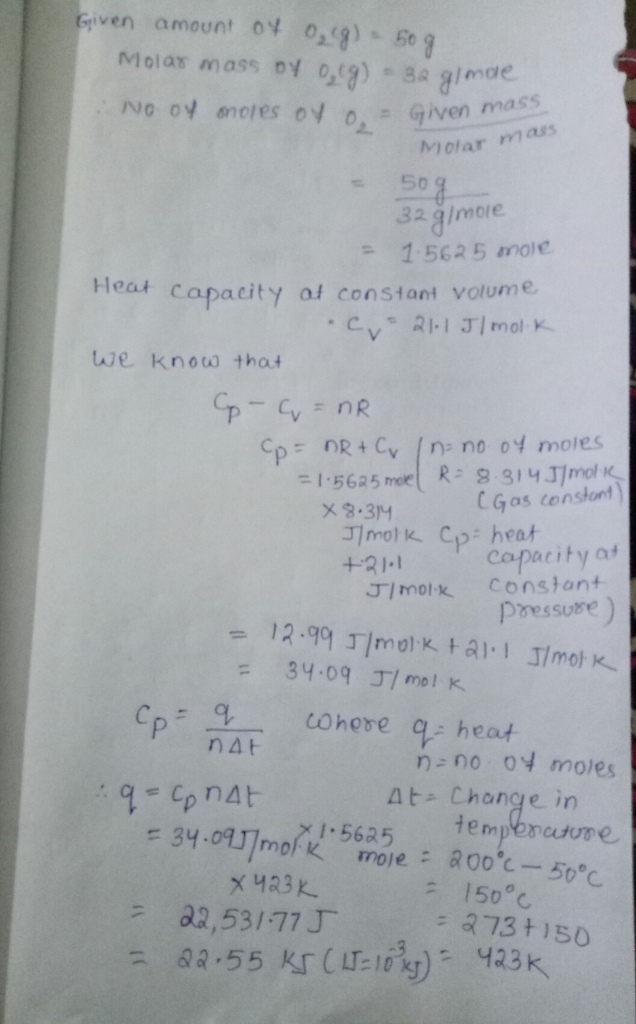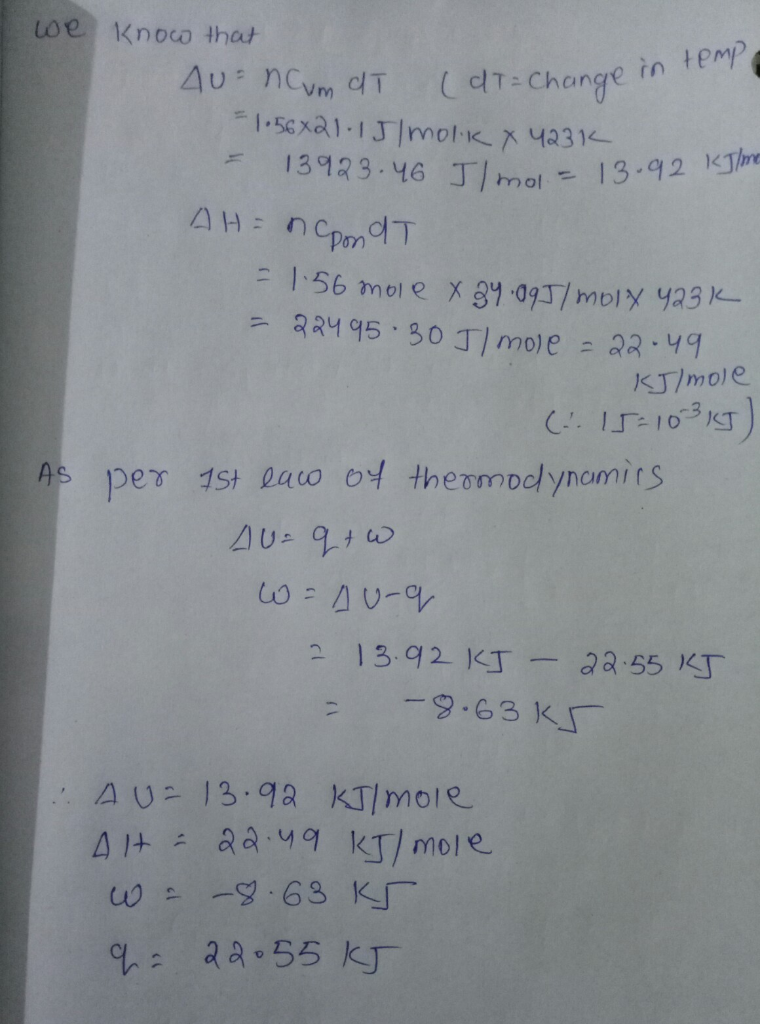Question
In: Chemistry
10. Calculate q, w, ∆U, and ∆H when 50 g of O2(g) is heated at a...
10. Calculate q, w, ∆U, and ∆H when 50 g of O2(g) is heated at a constant pressure of 1 bar from 50 ºC to 200 ºC. Note: The constant volume heat capacity of O2 is 21.1 J mol-1 K-1.
Solutions
Related Solutions
what are ∆U, ∆H, ∆G, ∆A, ∆S, ∆Ssur, q and w for the following changes involving...
what are ∆U, ∆H, ∆G, ∆A, ∆S, ∆Ssur, q and w for the following
changes involving a perfect diatomic gas – if all changes are
reversible –
(a) isentropic change
(b) isochoric change
(c) isobaric change
(d) isothermal change
(e) isenthalpic change
(entropy S, enthalpy H, Gibbs energy G and Helmholtz energy
A)
Note, the perfect gas equation of state is pV = nRT.
Calculate W,Q, Change of U, change of H ,and Change of S for the following two...
Calculate W,Q, Change of U, change of H ,and Change of S for the
following two separate processes involved one mole of ideal gas(Cp=
3.5R) with the same initial state at 100kpa and 300k
A) the gas expands adiabatically and mechanical reversibly to
20kpa.
B) the gas expands to the same final state as process a) but it
expands irreversibly with an efficiency of 60% compared with the
reversible process a)
Calculate q, w, ∆U and ∆H for 1.00 mole of a monatomic ideal gas which undergoes...
Calculate q, w, ∆U and ∆H for 1.00 mole of a monatomic ideal gas
which undergoes a change of state along two different paths. (Note
that the initial and final states are the same for both paths.)
Report all energies in joules.
Path I: Reversible isothermal compression at T= 298 K from 1.00
bar to 2.00 bar.
Path II: (2 steps)
1. Isobaric (constant
pressure) cooling of the gas at 1.00 bar until the volume of the
gas is equal...
Calculate the enthalpy of the reaction 2NO(g)+O2(g)?2NO2(g) given the following reactions and enthalpies of formation: 12N2(g)+O2(g)?NO2(g), ?H?A=33.2...
Calculate the enthalpy of the reaction
2NO(g)+O2(g)?2NO2(g)
given the following reactions and enthalpies of formation:
12N2(g)+O2(g)?NO2(g), ?H?A=33.2 kJ
12N2(g)+12O2(g)?NO(g), ?H?B=90.2 kJ
Express your answer with the appropriate units.
?H? =
Part B
Calculate the enthalpy of the reaction
4B(s)+3O2(g)?2B2O3(s)
given the following pertinent information:
B2O3(s)+3H2O(g)?3O2(g)+B2H6(g), ?H?A=+2035
kJ
2B(s)+3H2(g)?B2H6(g), ?H?B=+36
kJ
H2(g)+12O2(g)?H2O(l), ?H?C=?285
kJ
H2O(l)?H2O(g), ?H?D=+44
kJ
Express your answer with the appropriate units.
?H? =
When heated, KClO3 decomposes into KCl and O2. 2KClO3 ----> 2KCl + 3 O2 If this...
When heated, KClO3 decomposes into KCl and O2.
2KClO3 ----> 2KCl + 3 O2
If this reaction produced 95.9 g KCl, how many grams
of O2 were produced?
Hess's Law Calculate the Value of H for: 3NO2(g)+2H2O(l) = 2HNO3(aq)+NO(g) Using this information: 2NO(g)+O2(g) =...
Hess's Law Calculate the Value of H for: 3NO2(g)+2H2O(l) =
2HNO3(aq)+NO(g)
Using this information: 2NO(g)+O2(g) = 2NO2(g) , H=-116 kJ
2N2(g)+5 O2(g)+2H2O(l) = 4HNO3(aq) , H= -256kJ
N2(g) + O2(g) = 2NO(g) , H=+183kJ
A 5-cm diameter copper ball is heated to 300 C. Take h = 10 W/m^2*K. A)...
A 5-cm diameter copper ball is heated to 300 C. Take h = 10
W/m^2*K.
A) Make a graph of temperature versus time for copper then for
aluminum. Include the Matlab script or Excel data tables for these
2 graphs.
B) What value of K would make it so that this situation could
not be treated as a lumpted system (Biot-Number < 0.1)?
A 2-Kg mixture of 20% N2 , 30% O2 and 50% CO2 by mass is heated...
A 2-Kg mixture of 20% N2 , 30% O2 and 50% CO2 by mass is heated
to 500 K with constant volume. Find The final pressure and the
total heat transfer needed.
(a) when 1/2N2(g)+3/2H2(g)?NH3(g) for NH3(g) find the value of ?H?f. (b) when S(s)+O2(g)?SO2(g) For SO2(g) find...
(a) when 1/2N2(g)+3/2H2(g)?NH3(g)
for NH3(g) find the value of
?H?f.
(b) when S(s)+O2(g)?SO2(g)
For SO2(g) find the value of
?H?f.
(c) when Rb(s)+12Cl2(g)+32O2(g)?RbClO3(s)
For RbClO3(s) find the value of
?H?f.
g)When at least 50% copper material is alloyed with ..............................., ……………. material is obtained h)Alloys with...
g)When at least 50% copper material is alloyed with
..............................., ……………. material is obtained
h)Alloys with the highest strength / weight ratio ……………… are
used in prosthesis and implant production
i)…………… used in coating canned cans, it is also used in the
production of …………… material in joining processes)
j)………….plastic materials that do not melt when exposed to heat
are produced by the method of ……………………… ..….)
k)…………………………… is used in the production of gaskets and
tires)
l)The ………………..strength of...
ADVERTISEMENT
ADVERTISEMENT
Latest Questions
- A) Determine the acceleration of a 25.0 kg mass down a frictionless incline plane (angle of...
- Draw orbital diagrams for atoms with the following electron configurations: 1s22s22p63s23p64s23d7 Define the following terms and...
- labeling of bone formation
- Which of the following is not one of the considerations given to capital budgeting proposals? Select...
- Consider a casino game that an individual (Joe) wants to play. It costs him N dollars...
- Bergamo Bay's computer system generated the following trial balance on December 31, 2019. The company’s manager...
- Could i get a walk trough how to solve these questions. Note that is where the...
ADVERTISEMENT


 queen_honey_blossom answered 1 month ago
queen_honey_blossom answered 1 month ago